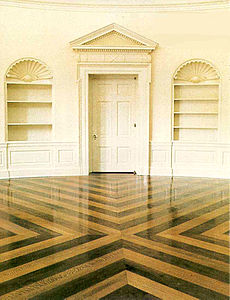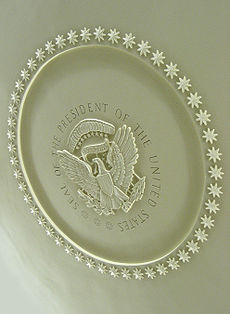Oval Office
This template is a customized wrapper for {{[[Template:{{{1}}}|{{{1}}}]]}}. Any field from {{[[Template:{{{1}}}|{{{1}}}]]}} can work so long as it is added to this template first. Questions? Just ask here or over at [[Template talk:{{{1}}}]]. |
|

|-
|

|-
|

|-
|

|-
|

|-
|

|-
|

|-
|

|}
The Oval Office is the official office of the President of the United States. Located in the West Wing of the White House, the elliptical-shaped office features three large south-facing windows behind the president's desk and a fireplace at the north end of the room.
The Oval Office has four doors: the east door opens to the Rose Garden; the west door leads to a private smaller study and dining room; the northwest door opens onto the main corridor of the West Wing; and the northeast door opens to the office of the president's secretary.
- Dimensions
- Major north-south axis: 35' 10" (10.9m)
- Minor axis east-west axis: 29' (8.8m)
- Height: 18' 6" (5.6m)
- Line of rise (the point at which the ceiling starts to arch): 16' 7" (5.0m)
Architecture and furnishings
Though architect James Hoban's original design for the White House included two oval rooms, the idea of an oval office did not come about until 1909. An oval interior space is a Baroque concept that was adapted by Neoclassicism. Oval rooms became popular in eighteenth century neoclassical architecture, and it is considered likely that Hoban was influenced by the elliptical chamber at Castle Coole in County Fermanagh, Northern Ireland. That room has identical dimensions, and includes the two recessed niches found in Hoban's original design for the Blue Room. The "elliptic salon"—in the form of the Blue Room and Yellow Oval Room—was the outstanding feature of James Hoban's original plan of the White House. At the temporary "President's House" in Philadelphia, George Washington had two rooms each modified with an apsidal bowed end, which were used for hosting the formal receptions called levees. As his guests formed a circle around him, Washington could stand in the center with everyone an equal distance from the president. The apsidal end of a room was a traditional site of honor, for a host, a potentate, or the magistrate in a basilica.
The president's working office moved from the main residence to the newly constructed West Wing in 1902. At first the president had a rectangular office in the West Wing located just west of the present Cabinet Room. The first Oval Office in the West Wing was designed by Nathan C. Wyeth and constructed in 1909, during the administration of Taft. That office was centered east to west on the south side of the West Wing, much as the oval rooms in the White House residence are. President Taft intended the Oval Office to be the center of his administration. By locating it in the center of the West Wing, he could be more involved with the day-to-day operation of his presidency. The Taft Oval Office had simple Georgian Revival trim, and was likely the most colorful in history; the walls were covered in a vibrant green seagrass. A post card from late in 1909 shown on the right shows Taft's Oval Office.
On December 24, 1929, during the Herbert Hoover administration a fire damaged the West Wing requiring substantial rebuilding. President Hoover rebuilt the Oval Office in the same location, upgrading the quality of trim and having the first air conditioning installed. Dissatisfied with the size and layout of the West Wing, President Franklin D. Roosevelt engaged a staff architect, Eric Gugler, to redesign the West Wing with the Oval Office placed in the southeast corner, offering more privacy, and easier access to the residence. President Roosevelt worked closely with Eric Gugler and devised a room architecturally grander than the previous two rooms, with more robust Georgian details: doors topped with substantial pediment hoods, bookcases set into niches, a deep bracketed crown molding and a ceiling medallion of the presidential seal. In small ways hints of Art Moderne can be seen, especially in the representation of the eagle in the ceiling medallion. Roosevelt and Gugler worked closely together, often over breakfast, with Gugler sketching the president's ideas. One notion resulting from these sketches that has become fixed in the layout of the room's furniture, is that of two high back chairs in front of the fireplace. The public sees this most often with the president seated on the left, and a visiting head of state on the right. This allowed President Roosevelt to be seated, with his guests at the same level, deemphasizing his inability to stand on his own accord.
A tradition evolved in the latter part of the twentieth century of each new administration redecorating the office to the President's liking. A new administration usually selects an oval carpet, new drapery, the paintings on the walls, and some furniture. Most incoming presidents continue using the rug of their predecessor until their new one is installed. The retired carpet very often is then moved to the presidential library of the president for whom it was made. The redecoration of the Oval Office is usually coordinated by the First Lady's office in the East Wing, working with an interior designer and the White House Curator. Art may be selected from the White House collection, or may be borrowed for the length of an administration. President Clinton borrowed a bronze sculpture of The Thinker by Auguste Rodin from a museum. President George W. Bush has borrowed an oil painting titled A Charge to Keep from a longtime Texan friend. Sometimes the look of one administration's Oval Office evolves over time. President George W. Bush at first had the two highback Martha Washington style "lolling chairs" in front of the fireplace upholstered in shades of tan, sage and melon. Media reports referring to the new fabric's melon color as "pink" caused him to request a new fabric replacing the melon with a medium blue.
The desk used by many presidents in the Oval Office is a large partners' desk called the Resolute desk, so named because it was built from the timbers of the British frigate HMS Resolute. The desk was a gift of British Queen Victoria to President Rutherford B. Hayes in 1880. Most recent presidents have hung a portrait of Washington over the mantel on the north end of the room. A tradition of displaying potted Swedish ivy (Plectranthus australis) atop the mantel goes back to the Kennedy administration, and the current plants were rooted from the original plant. A series of bronze sculptures of horses and Western themes by Frederic Remington (1861-1909) are often displayed in the room. A large case clock, commonly called a grandfather clock, built in Boston by John and Thomas Seymour, c. 1795-1805, stands in the northeast portion of the room.
History
The Oval Office has become associated in Americans' minds with the presidency itself, through memorable images, such as a young John F. Kennedy, Jr. peering through the front panel of his father's desk, Richard Nixon speaking by telephone with the Apollo 11 astronauts after their successful voyage, or Amy Carter bringing her Siamese cat Misty Malarky Ying Yang to brighten President Jimmy Carter's day. Use of the Oval Office for television broadcasts has a sense of gravity, as when President Kennedy presented news of the Cuban missile crisis, or President Ronald Reagan addressed the nation following the explosion of the space shuttle Challenger.
Oval Office carpet
The carpet of the oval office bears the Seal of the President. There is a popular misconception that the seal changes during time of war, with the eagle's head turning from the olive branch to the arrows, however the design of the seal has not changed since Truman redesigned the Seal in 1945. President Truman's elliptical carpet was the first to incorporate the presidential seal. In Truman's carpet the seal was represented monochromatically through varying depths of the cut pile. His carpet was used in the Eisenhower and Kennedy administrations. In recent years most administrations have created their own rug working with an interior designer and the Curator of the White House.
Design and materials
Since the present Oval Office's construction in 1934 during the administration of Franklin Delano Roosevelt the room has remained mostly unchanged architecturally. More than any president, FDR left an impression on the room and its use. Doors and window frames have been modified slightly. A domestic screen door on the east wall was removed after the installation of air conditioning. During the Cold War window panes were outfitted with small vibrators when it was learned that the Soviets had developed a means of reading the effect of voice sound waves on glass panes. President Johnson's row of wire service teletype machines on the southeast wall required cutting plaster and flooring to accommodate wiring. The Georgian style plaster ornament has been cleaned to remove accumulated paint, and a series of electrified wall sconces have come and gone.
Though some presidents have chosen to do day to day work in a smaller study just west of the Oval Office, most use the actual Oval Office for work and meetings. Traffic from the large numbers of staff, visitors, and pets over time take their toll. There have been four sets of flooring in the Oval Office. The original floor was made of cork installed over soft wood, however President Eisenhower was an avid golfer and damaged the floor with his golf spikes. President Johnson had the floor replaced in the mid-1960s with wood-grain linoleum. In 1982, embarrassed by the linoleum floor, President Reagan had the floor replaced with white pine and oak in a radial parquet pattern similar in design to Eric Gugler's 1933 sketch which was never installed. In August of 2005, the floor was replaced again under George W. Bush, in nearly the same pattern as the Reagan floor but replacing the soft white pine with walnut.
In the late 1980s a comprehensive assessment of the entire house, including the Oval Office was made as part of the National Park Service's Historic American Building Survey (HABS). Detailed photographs and measured drawings were made documenting the interior and exterior and showing even slight imperfections. A checklist of materials and methods was generated for future conservation and restoration.
References and additional reading
- Portions of this article are based on public domain text from the White House.
- The White House: An Historic Guide. White House Historical Association and the National Geographic Society: 2001. ISBN 0-912308-79-6.
- Abbott James A., and Elaine M. Rice. Designing Camelot: The Kennedy White House Restoration. Van Nostrand Reinhold: 1998. ISBN 0-442-02532-7.
- Clinton, Hillary Rodham. An Invitation to the White House: At Home with History. Simon & Schuster: 2000. ISBN 0-684-85799-5.
- Monkman, Betty C. The White House: The Historic Furnishing & First Families. Abbeville Press: 2000. ISBN 0-7892-0624-2.
- Ryan, William and Desmond Guinness. The White House: An Architectural History. McGraw Hill Book Company: 1980. ISBN 0-07-054352-6.
- Seale, William. The President's House. White House Historical Association and the National Geographic Society: 1986. ISBN 0-912308-28-1.
- Seale, William, The White House: The History of an American Idea. White House Historical Association: 1992, 2001. ISBN 0-912308-85-0.
- West, J.B. with Mary Lynn Kotz. Upstairs at the White House: My Life with the First Ladies. Coward, McCann & Geoghegan: 1973. SBN 698-10546-X.
External links
- Oval Office historical photo essay
- Washington Post: "Inside the Real West Wing"
- White House Museum online tour: the Oval Office, with history and images from each administration
- President George W. Bush White House video tour of the Oval Office
- Google Sketchup 3D Model
- Template:Geolinks-US-buildingscale
